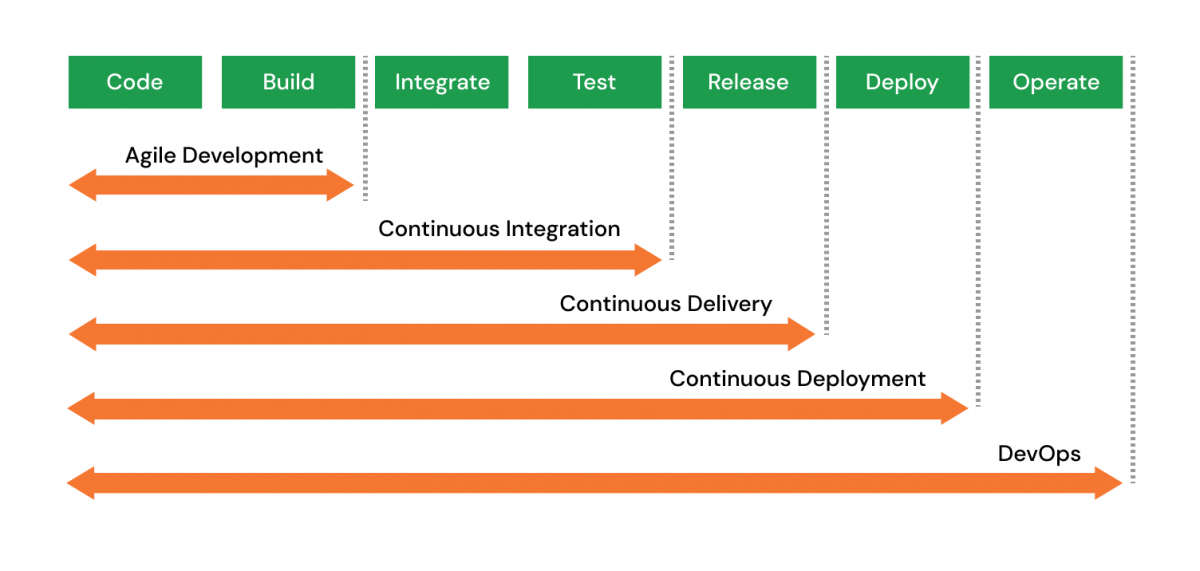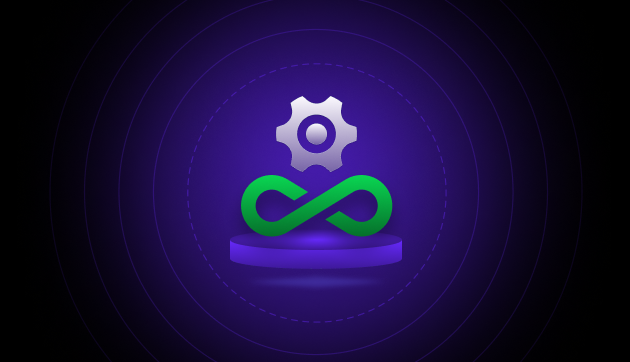
Continuous Integration vs Continuous Deployment in DevOps (A Comprehensive Guide)
Sep 24, 2024 6 Min Read 2943 Views
(Last Updated)
DevOps is a way of making software that brings together the people who create it and those who keep it running smoothly. It’s a team where everyone works together to make and deliver software quickly and efficiently. In this teamwork, two key players are Continuous Integration (CI) and Continuous Deployment (CD).
Think of CI as a process where everyone working on the software regularly adds their changes to a shared place. This helps in catching any problems early and makes it easier to combine everyone’s work without big headaches.
CD, on the other hand, is an automatic conveyor belt that takes the software, once it’s ready and tested, straight to the users without any delay. It’s all about getting new features and fixes to the users fast and frequently. Sometimes people get confused between CI and CD because they sound similar but do different things.
That’s why in this blog, we’re going to talk about what Continuous Integration vs Continuous Deployment really are, how they’re different, and why they’re so important in making software the DevOps way.
Table of contents
- Continuous Integration (CI)
- Key Principles of CI:
- How CI Works in a DevOps Environment?
- Benefits of Implementing CI:
- Challenges and Common Pitfalls in CI:
- Continuous Deployment (CD)
- Core Elements of CD:
- Workflow of CD in a DevOps Setting
- Advantages of Using CD:
- Potential Hurdles and How to Overcome Them in CD
- CI/CD: Continuous Integration vs Continuous Deployment
- Similarities between CI (Continuous Integration) and CD (Continuous Deployment)
- Key Differences
- Use Case Scenarios: When to Use CI, CD, or Both
- Integrating CI/CD into DevOps
- Best Practices for Integrating CI/CD into DevOps
- Tools Commonly Used for CI/CD in DevOps
- Case Studies or Success Stories
- Future Trends in CI/CD
- Emerging Trends and Technologies in CI/CD
- How These Trends Might Shape the Future of DevOps
- Conclusion
- FAQs
- What is the main difference between Continuous Integration (CI) and Continuous Deployment (CD) in DevOps?
- Can you implement Continuous Deployment (CD) without Continuous Integration (CI)?
- How do Continuous Integration and Continuous Deployment improve software development and operations in DevOps?
Continuous Integration (CI)
Continuous Integration (CI) is a software development practice where developers frequently merge their code changes into a central repository, preferably several times a day. Each integration can then be verified by an automated build and automated tests. This approach aims to detect and fix integration problems early, leading to better collaboration and software quality.
Before we move to the next part, you should have a deeper knowledge of DevOps concepts. You can consider enrolling yourself in GUVI’s DevOps Course, which lets you gain practical experience by developing real-world projects and covers technologies including Agile, Scrum, Linux, Git, Bash Scripting, Dockers, Containers, AWS infrastructure, etc.
Additionally, if you would like to explore AWS Infrastructure through a Self-paced course, try GUVI’s AWS Infrastructure certification course.
Key Principles of CI:
- Frequent Code Integration: Regularly merging code changes into a central repository.
- Automated Testing: Running tests automatically to ensure each integration meets the desired quality standards.
- Fast Build Process: Ensuring that the build process is quick to facilitate frequent integrations.
- Maintain a Single Source of Truth: Having a central code repository where all code changes are merged.
- Immediate Fixing of Issues: Addressing and resolving issues as soon as they are detected.
How CI Works in a DevOps Environment?
In a DevOps setting, CI is a critical component that bridges the gap between development and operations. Developers commit changes to the repository, and CI tools automatically perform builds and tests. This ensures that the software is always in a releasable state, facilitating continuous delivery and deployment. It supports a culture of shared responsibility, where both development and operations collaborate closely.
Benefits of Implementing CI:
- Reduced Integration Issues: Regular integration reduces the complexity of merging changes.
- Faster Release Rate: With more efficient processes, software can be released to users more quickly.
- Improved Software Quality: Consistent testing leads to fewer bugs and higher-quality software.
- Enhanced Team Collaboration: Encourages transparency and collaboration among team members.
- Early Detection of Problems: Issues are detected and addressed earlier in the development cycle.
Challenges and Common Pitfalls in CI:
- Initial Setup and Learning Curve: Setting up CI tools and processes can be challenging.
- Maintaining a Reliable Test Suite: Ensuring that automated tests are effective and cover sufficient aspects of the software.
- Dealing with a High Volume of Builds: Managing and prioritizing a large number of builds can be difficult.
- Balancing Speed with Quality: Ensuring that the speed of integration does not compromise software quality.
- Resistance to Cultural Change: Adapting to a CI methodology requires a shift in team culture and mindset.

Continuous Deployment (CD)
Continuous Deployment (CD) is an advanced software release process where every change that passes the automated tests is automatically deployed to the production environment. It’s a step beyond Continuous Integration, ensuring a fully automated path from code commit to deployment, making software releases swift and frequent.
Core Elements of CD:
- Automated Deployment: The process of deploying software to production is fully automated.
- Robust Testing Framework: Automated tests must be thorough and reliable to ensure only quality code is deployed.
- Real-time Monitoring and Feedback: Continuous monitoring of the deployed software for immediate feedback on performance and user experience.
- Rapid Rollback Mechanisms: Ability to quickly revert to a previous version if a new release introduces issues.
Workflow of CD in a DevOps Setting
In a DevOps environment, CD automates the software release process. Once developers commit code and it passes CI processes (like build and test), CD tools automatically deploy this code to the production environment. This creates a seamless and efficient workflow where operations and deployment are integrated into the development process, leading to a faster and more reliable software delivery cycle.
Advantages of Using CD:
- Faster Time-to-Market: Quick deployments mean new features reach users faster.
- Higher Quality and Stability: Continuous testing and feedback loops improve software quality.
- Efficient Resource Utilization: Automation reduces the need for manual intervention, freeing up resources.
- Improved Customer Satisfaction: Regular updates and swift issue resolution lead to a better user experience.
- Enhanced Team Productivity: Teams can focus on development rather than deployment tasks.
Potential Hurdles and How to Overcome Them in CD
- Ensuring Quality in Automated Tests: Invest in creating and maintaining a robust test suite.
- Managing Complex Deployments: Break down deployments into smaller, manageable units.
- Dealing with Downtime and Rollbacks: Implement strategies like blue-green deployments to minimize downtime.
- Cultural Resistance to Automation: Educate teams on the benefits of CD and foster a culture of continuous improvement.
- Security Concerns: Integrate security practices into the CD pipeline (DevSecOps).

CI/CD: Continuous Integration vs Continuous Deployment
The comparison between CI and CD is explained below in detail:
Similarities between CI (Continuous Integration) and CD (Continuous Deployment)
Automation Focus: Both CI and CD emphasize automating parts of the software development process.
Frequent Code Integrations/Deployments: They both aim to make changes more frequent, either through integration or deployment.
Quality Improvement: CI and CD focus on improving the quality of software through regular testing and feedback.
DevOps Practices: They are integral components of DevOps, fostering collaboration and efficiency.
Key Differences
a. Process Flow
– CI: Involves developers frequently merging their code changes into a main repository, followed by automated builds and tests.
– CD: Extends CI by automatically deploying all code changes to the production environment after passing tests.
b. Degree of Automation
– CI: Automation is primarily focused on testing and validating code changes.
– CD: Takes automation further, encompassing the entire process from code integration to deployment in the production environment.
c. Role in the Software Development Lifecycle
– CI: Plays a role in the early stages of development, ensuring code integrations are smooth and error-free.
– CD: Affects later stages, focusing on delivering the integrated and tested code to the end-users.
Use Case Scenarios: When to Use CI, CD, or Both
CI Only: Ideal for projects that require frequent code validation but where manual control over deployment is necessary (e.g., complex enterprise systems).
CD Only: Rarely used alone; CD usually builds on the principles of CI.
Both CI and CD: Best for projects aiming for full automation, rapid delivery, and where continuous updates are essential (e.g., consumer-facing web apps, SaaS products).
Also Read: 10 Best DevOps Project Ideas

Integrating CI/CD into DevOps
Continuous Integration (CI) and Continuous Deployment (CD) are more than just tools or processes; they embody the philosophy of DevOps. By integrating CI/CD, teams achieve:
Collaboration and Efficiency: Breaking down silos between development and operations.
Rapid Feedback and Iteration: Enabling quick iterations and improvements based on continuous feedback.
Automated, Streamlined Workflows: Reducing manual work and errors, leading to more efficient development cycles.
Best Practices for Integrating CI/CD into DevOps
- Cultivate a Culture of Continuous Improvement: Encourage team members to embrace change and learn from feedback.
- Automate as Much as Possible: From code integration, testing, to deployment – aim for high levels of automation.
- Maintain a Robust Testing Framework: Ensure that automated tests are reliable and cover a wide range of scenarios.
- Monitor and Measure Performance Regularly: Use monitoring tools to track the performance of your deployments.
- Foster Collaboration Among Teams: Facilitate communication between developers, testers, and operations staff.
Tools Commonly Used for CI/CD in DevOps
- Jenkins: An open-source automation server that facilitates CI and CD.
- Travis CI: A hosted CI service used for building and testing projects hosted on GitHub.
- CircleCI: Provides CI/CD for web applications.
- GitLab CI/CD: An integrated CI/CD service for GitLab projects.
- Spinnaker: An open-source, multi-cloud continuous delivery platform for releasing software changes.
Also Read: Top DevOps Tools You Should Know
Case Studies or Success Stories
- Netflix: Known for its sophisticated DevOps model. Netflix uses Spinnaker for CD, allowing them to deploy thousands of times per day.
- Etsy: Transitioned to a DevOps model with an emphasis on CI/CD, resulting in faster deployment cycles and improved site reliability.
- Adobe: Implemented CI/CD practices to streamline processes and improve collaboration, leading to increased productivity and faster time-to-market.

Future Trends in CI/CD
The landscape of Continuous Integration (CI) and Continuous Deployment (CD) is constantly evolving, driven by new technologies and the ever-changing demands of software development. Understanding these emerging trends can help anticipate how they might shape the future of DevOps.
Emerging Trends and Technologies in CI/CD
- Integration of Artificial Intelligence and Machine Learning: AI/ML can analyze patterns in code and operations, predicting and preventing potential issues, and automating complex decision-making in CI/CD pipelines.
- Increased Adoption of Microservices Architecture: This approach enhances the scalability and flexibility of CI/CD pipelines, allowing for more efficient management of complex systems.
- Shift Towards Serverless Computing: Serverless architectures reduce the overhead of managing servers and infrastructure, focusing more on code and deployment processes.
- Rise of DevSecOps: Integrating security practices directly into CI/CD pipelines to ensure that every release is secure by design.
- Use of Containers and Kubernetes: These technologies simplify the deployment process, making it more consistent and scalable across different environments.
Also Read: How Is AI Transforming DevOps? Check 7 Intriguing Ways!
How These Trends Might Shape the Future of DevOps
Enhanced Efficiency and Productivity: With AI and automation, teams can focus on creative problem-solving rather than routine tasks.
Improved Software Quality and Security: Integrating security into CI/CD pipelines ensures continuous compliance and security, reducing the risk of vulnerabilities.
Greater Scalability and Flexibility: Microservices and serverless computing allow DevOps teams to scale and adapt more easily to changing requirements.
Increased Collaboration and Innovation: These evolving technologies foster a culture of continuous learning and improvement, essential for innovation in software development.

Kickstart your career by enrolling in GUVI’s DevOps Course where you will master technologies including Linux, Git, AWS, etc, and build interesting real-life devops projects.
Alternatively, if you want to explore AWS infrastructure through a Self-paced course, try GUVI’s AWS Infrastructure certification course.
Conclusion
Understanding and using CI and CD in DevOps is really important. It’s not just about making software faster; it’s about making it better and in a way that everyone works well together.
If you make software, manage it, or are just interested in this stuff, think about how you can use CI and CD in your work. It might seem a bit tricky at first, but it’s worth it. These methods can help you make better software, catch mistakes early, and get your work to the people who use it faster.
So, go ahead, give it a try! Start small, learn as you go, and don’t be afraid to ask for help or look up more information. By getting into CI and CD, you’ll be joining a big community of people who are working smarter and making better software every day.
FAQs
What is the main difference between Continuous Integration (CI) and Continuous Deployment (CD) in DevOps?
The main difference lies in their scope and focus within the software development process. Continuous Integration (CI) is about regularly merging code changes into a shared repository, where they are automatically tested to ensure compatibility and quality.
It focuses on the early stages of development. Continuous Deployment (CD), on the other hand, takes this a step further by automatically deploying the code to the production environment after it passes all tests, thereby focusing on delivering the final product to the users.
Can you implement Continuous Deployment (CD) without Continuous Integration (CI)?
While theoretically possible, it’s not recommended. Continuous Deployment (CD) builds upon the principles and practices of Continuous Integration (CI). CI ensures that the code is always in a state that is ready to be deployed, which is crucial for the success of CD.
Without CI, CD would lack the foundational stability and quality assurance needed for safe and reliable deployment to production.
How do Continuous Integration and Continuous Deployment improve software development and operations in DevOps?
CI and CD improve software development and operations by automating key parts of the development process, enhancing collaboration, and speeding up the delivery of software.
CI allows for early detection of issues, reducing integration problems and improving code quality.
CD ensures that the latest, tested version of the software is always available to users, which leads to quicker feedback and faster iterations. Together, they make the development process more efficient, reliable, and responsive to user needs.






















![10 Impressive Docker Project Ideas [With Source Code] 7 Docker Project Ideas](https://www.guvi.in/blog/wp-content/uploads/2024/11/Docker-Project-Ideas.png)





![Top High-Paying Non-Coding Jobs in DevOps [2024] 13 Non-Coding Jobs in DevOps](https://www.guvi.in/blog/wp-content/uploads/2023/11/Top-10-Non-Coding-Jobs-in-DevOps.png)
Did you enjoy this article?